Talking Trees - Stanley Park (k-12)
Talking Trees – Student Program (K to Grade 12)
Welcome to our TALKING TREES - School Program | Presented by Talaysay Tours
Type of Program: Student Indigenous Walking Tour - Ecology
Tour Description: This is a walking tour in Stanley Park. Your Talaysay Cultural Land Ambassador(s) / Guide(s) will take you on a forest walk and teach the rich stories and history of the land while you learn how the trees and plants are used by indigenous people for both food and medicine. Learn to identify a variety of indigenous plants and tree species so when you venture into the forest you too will know what is edible, medicinal and adaptable for technology. Emphasis on Indigenous Ways of Knowing, Sustainable Practices and Ecology.
Date of Tour: Monday to Friday
Start Time: 10:00 am End Time: 11:30 am Duration: 1.5 hrs We can book custom times between 9:00 am and 10:30 am for the morning tour and 12:00 pm and 1:30 pm for the Afternoon Tour.
Includes: Guide-Ambassador-Instructor. At times we have a co-guide, a trainer and or a trainee. The tour is rich with Indigenous stories and interpretation. Students have the opportunity to discuss and ask questions during the tour and or in the last 15 minutes of the tour.
Student Rate with 20 or more participants: $32.00 / participant + GST & Fees (This Rate is for K to 12 Students Only).
With 20+ students, 1 teachers or adult volunteers is complimentary. When there are less than 20 students, the base rate is $640 + GST & Fees.
Primary Location: Stanley Park:
This tour meets at the Stanley Park bus loop which is accessible by car, taxi, bus or by foot. Our guide will meet you under the gazebo in the bus loop. Please note, if driving by car, the parking lot is all pay parking. If taking the public bus, it is the #19 bus to Stanley Park and it is the last stop.
If traveling by school bus, the driver can drop the students off then park at the designated bus parking in Stanley Park.
Please provide yourself plenty of time to arrive and find your guide.
Custom Locations:
When planned in advance, our Cultural Land Ambassadors could travel to a forest area near your school. Review of the site for safety, access and diversity in Indigenous plants is required. There is an additional $115.00 + GST & Fees cost for travel related fees for us to come to a custom location.
Inquiring and Bookings: Please email info@talaysay.com or contact us at 1-800-605-4643 (Toll Free) or 604-628-8555 (Vancouver line)
Our Tour Line-Up:
1. Talking Trees - Nature Based (90 min)
2. Spoken Treasures - History Based (75 min)
3. Talking Totems - Art & Culture Based (60 min)
4. Love the Land - Nature & History (90 min) | North Vancouver
5. Salish Sea & Me - Ocean / Nature & History Based (90 Min)
6. Workshops & In-class presentations:
We can turn any of our tours into a presentation / workshop. Contact us for activities.
Locations: Vancouver, North Shore, Sunshine Coast, Squamish
Dates and Times: can be customized with groups.
Wishing you a great week ahead and look forward to planning further with you both.
Media:
Land Based Learning:
https://www.youtube.com/watch?v=ahAFvrl90e4
Talking Totems:
https://www.youtube.com/watch?v=ww0P01Ehtgo
Spoken Treasures:
https://www.youtube.com/watch?v=c7JbZgnnNKg
Talaysay Virtual Tours:
https://www.youtube.com/watch?v=SZ-4KWXx5p0
https://www.youtube.com/watch?v=P-LY2tTLzrc
Liz V | Reservations Manager - info@talaysay.com
Talaysay Campo | Co-Owner / Regional Manager
Talaysay Tours - Authentic Indigenous Cultural Experiences | www.talaysay.com

Covid Safety Practices: We invite guests to wear a mask. We follow the 2 meter distance safety practice and ask for your support in maintaining this safety guideline. We ask guests to use hand sanitizer before and after all tours. At present we are not shaking hands and will happily share how we say thank you the Coast Salish hand gesture. We will not be sharing our traditional drink during this period of managing the covid curve. If you have any allergies or medical conditions you think we should know, please give us a call or send us an email. If you are sick or have a fever, we ask you to stay home and we will reschedule you within our scheduled operational season. Covid Best Practices: https://www.worksafenb.ca/media/61124/embracing-the-new-normal-poster.pdf
Method of Payment:
1. Online at: www.talaysay.com
2. Invoice in advance: EFT, Cheque, E-transfer.






